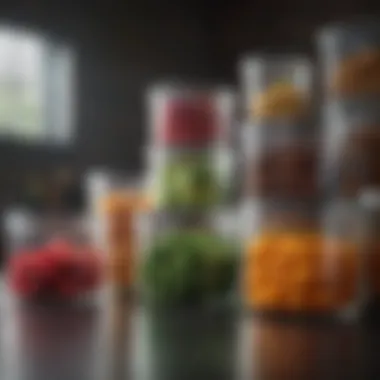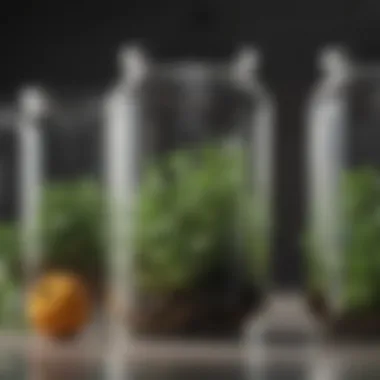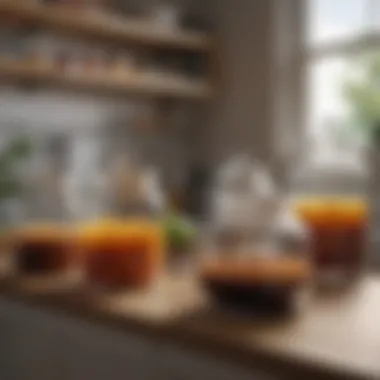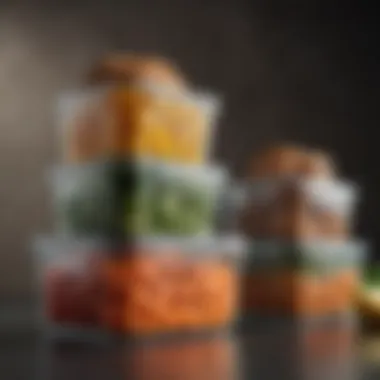The Benefits of Glass Containers for Food Preparation


Intro
The use of glass containers in food preparation has garnered attention due to their distinct advantages over plastic or metal alternatives. This article takes a closer look at the practicality of glass containers, emphasizing their role in safety, functionality, environmental sustainability, and long-term savings. Understanding these factors can be essential for consumers seeking effective storage solutions that align with modern wellness goals.
Safety Considerations
One of the most significant reasons to choose glass containers is safety. Unlike some plastics, glass does not leach harmful chemicals into food. This makes it a preferred choice for storing both hot and cold items. Also, glass does not absorb odors or stain easily, maintaining the integrity of food flavors.
Glass containers are inherently safe for heating due to their high thermal resistance and moisture impermeability. This can be critical when preparing various meals.
Functional Advantages
When it comes to functionality, glass containers offer several benefits.
- Durability: Glass is resistant to scratches and maintains a clean appearance even after extensive use.
- Versatility: These containers can go from oven to table, making them suitable for various cooking methods.
- Visibility: Transparent glass allows for easily identifying contents without opening.
These functional features contribute to more efficient meal prep and skillful cooking techniques.
Environmental Impact
Using glass instead of plastic can significantly reduce environmental waste. Glass is recyclable and can be reused many times, unlike disposable plastic options. This switch lessens pollution and overall support for sustainable practices. Choosing glass supports an eco-friendly lifestyle, especially in a context of recurrent discussions on waste management and climate change.
Long-term Cost Effectiveness
Investing in high-quality glass containers can yield savings over time. Initially, the purchase cost might be higher than plastic ware, but their durability means they last longer, reducing the need for replacements. This financial sense, combined with the health benefits, makes glass a wise choice in the kitchen. Once familiar with their benefits, consumers often find the transition to glass worth the effort.
With such attributes, glass containers indeed cater to the contemporary kitchen requirements. The decision to transition can have notable long-term benefits tailored specifically for better food preparation.
Finale
Glass containers for food preparation address safety, functionality, environmental, and economic needs efficiently. By creating a careful balance between practical utility and benefits, they stand out as a top choice for anyone, especially health professionals, who prioritize wellness in daily practices.
Prologue to Glass Containers
Glass containers have increasingly become a focal point in food preparation and storage. Their utility stretches across diverse culinary practices, offering advantages that not only enhance safety but also ensure versatility. With growing awareness towards health and environmental impacts, exploring glass containers isn't merely a trend; it's a consequential choice grounded in practicality.
The efficiency of glass for food preparation extends beyond mere aesthetics. Recipients can enjoy benefits such as chemical resistance, longevity, and aesthetic appeal. Additionally, seal and containment features of glass containers cater to various food types, making them efficient for meal prep and simultaneous storage.
Understanding glass containers can equip health professionals, wellness coaches, and nutritionists with practical options for advising clients. They represent a bridge linking convenience, hygiene, and sustainability, solidifying their place in modern kitchens.
Defining Glass Containers for Food Preparation
Glass containers for food preparation are multipurpose vessels comprised of glass, designed explicitly for storing and managing food items. These can range from jar-like structures used for preserving dried goods to rectangular dishes suited for baking and serving. While material composition defines the category, fundamental characteristics distinguish these containers.
Using glass imparts an idea of clarity in both design and function. For instance:
- They are usually non-reactive, offering a safe storage environment for food without leaching harmful chemicals.
- The transparency enables a quick visual check of contents without needing to open a container promptly. Post-usage, cleaning glass containers is straightforward, ensuring their utility mast be maximized, contributing significantly to food safety standards in professional kitchens and homes alike.
Historical Context of Food Storage
The act of food storage finds its roots in ancient practices. From pottery to wooden barrels, humans have sought effective ways to preserve vitality and taste. Though glass has been utilized for thousands of years, its introduction into food storage was gradual. In the early Roman Empire, glass would hold precious liquids rather than solid goods. It wasn’t until cleaner glass manufacturing processes emerged that public acceptance took place in food storage.
More recently, in the 19th century, the trend gained momentum. The Ball Brothers Glass Manufacturing Company and its introduction of canning jars popularized glass in home food preservation. Later, the 20th century further innovated the materials and technology of glass making, leading to various methods such as tempered and borosilicate glass. Poco by poco, glass containers matured into a household feel accepted and pratical utensils in food storage and preparation and thus became common in modern workspaces and homes.


Understanding the past of food storage through glass provides valuable context for evaluating its modern applications and advantages. As consumers redevelop dietary habits and reflect upon sustainable practices, the historical significance will help illuminate glass's integral role as smart choice compared to other materials.
Material Characteristics of Glass
Understanding the material characteristics of glass is key in evaluating its utility for food preparation. Glass offers unique benefits that make it a compelling choice for both casual cooks and professionals. Its specific elements have significant implications on durability, safety, and the overall culinary experience.
Durability and Resistance
Glass containers are known for their durability. Unlike plastic, glass is inherently resistant to scratching, which makes it less likely to harbor bacteria or other harmful microorganisms. This durability also decreases the risk of the containers breaking, particularly those made with borosilicate glass, designed to withstand thermal shock. Thus, a glass container can transition efficiently from refrigerator to microwave or oven without the fear of shattering.
In preparation contexts, resistance to environmental stressors means less frequent replacement of kitchen storage items, further establishing confidence in its reliability. Furthermore, the handlholds (and accesseyes) of glass can offer a visual appreciation of its condition over time, maintaining not just its functionality but also some aesthetic value.
"Investing in quality glass containers can enhance kitchen efficiency whilst reducing the frequency of replacement, creating a sustainable cycle of usage."
Common considerations when selecting glass containers should include thickness and the presence of tempered glass, associated with added strength and safety. Each of these characteristics emphasizes that durability is an inherent advantage allowing for diverse applications, such as food storage or meal prep.
Chemical Safety
When discussing chemical safety, glass is an exemplary material. Unlike certain plastics, glass does not leach harmful substances into food, nor does it develop chemical reactions with food substances. This characteristic is paramount, as health professionals regularly emphasize the links between food safety and container materials.
Materials used to formulate glass do not pose potential endocrinal disruptions or other harmful implications found in less safe alternatives. Consequently, individuals, including fitness trainers and wellness advocates, may be more confidently introduce diverse preparations into their kitchen routine. Through this lens, one can view glass containers not merely as storage solutions, but as pivotal allies in monitoring dietary health.
Health Considerations
Health considerations are paramount when choosing materials for food preparation. Glass containers offer significant benefits in terms of safety, especially when compared to alternatives like plastic. Understanding these health aspects helps in making better dietary choices and promoting overall well-being.
Non-Toxicity of Glass
Glass containers are known for their non-toxic nature. Unlike plastic, glass does not leach harmful chemicals into food. Common chemicals found in some plastics, such as Bisphenol A (BPA), can disrupt hormonal functions and pose health risks. It is important to note that glass is made from natural materials like sand, soda, and limestone, which means it is inert and does not interact with food. This provides peace of mind for individuals who are conscious about chemical exposure in their kitchens.
Research suggests that prolonged exposure to BPA can lead to health concerns, which solidifies the increased interest in using glass containers in food handling.
Furthermore, glass is dishwasher safe and can withstand high temperatures, making it ideal for reheating and freezing food without the risk of releasing toxins. This makes glass an excellent choice for those preparing meals in healthy and safe environments.
Absence of Hormone Disruptors
In modern dining, hormone disruptors are a matter of growing concern. Many kitchen storage options contain materials that contribute to these issues, particularly plastic. Glass containers, for example, do not contain these disruptive polymers found in plastics. Hormone disruptors affect metabolism, reproductive health, and overall endocrine function. By choosing glass, consumers take a significant step toward safeguarding their health from unintended exposure.
In addition to their safe composition, glass containers are also recyclable, which adds environmental benefits to their health-conscious qualities. As a result, they do not merely represent a choice for food safety but align with a broader aim of sustainability within lifestyle choices. Overall, the absence of hormone disruptors in glass is a solid advantage that advocates for its use explicitly in conscious food preparation.
Practical Applications
The practical applications of glass containers in food preparation are pivotal to understanding their advantages. These containers function not only as storage solutions but also as versatile tools in evaluating workflow in the kitchen. They enhance meal prep efficiency, optimize food organization, and cater to a variety of dietary needs.
Meal Prep Efficiency
Glass containers have increasingly become an integral part of meal preparation routines. The transparency of glass allows quick visibility of contents making it simpler to select required ingredients during cooking. Meal prep can become more productive when glass containers of various sizes and shapes are utilized. Utilizing appropriate storage designs can prevent waste and reduce repetitive tasks.
Being non-porous, glass containers do not absorb odors or stains from food, which promotes cleanliness without needing excessive scrubbing. A simple rinse often suffices. The containers can often be prepped ahead of time and stored in the refrigerator or freezer.
Some homeowners tend to use options like glass pyrex, often being microwave safe, enabling cooking directly in the same container without transferring food between different dishes. This saves both time and the number of dishes to wash.
Using glass containers boosts meal prep efficiency and reduces the mess in the kitchen, making cooking less cumbersome.


Versatility in Food Types
One of the remarkable aspects of glass containers lies in their compatibility with a wide variety of food types. Whether it is liquids, rigid grains, or even semi-solid preparations, these containers adapt impressively. Glass is impervious to permeation, thus preserving taste and freshness of items such as soups, salads, and cooked grains over time.
Moreover, glass can withstand temperature changes, allowing for seamless transitions from the freezer to the oven, making it ideal for individuals who might cook in bulk to build healthy meals for the upcoming days. This flexibility reflects not only on functionality but also encourages diverse meal plans involving various cuisines.
With varied shapes and sizes available in glass containers, meal planning becomes much more manageable. Food items can be well-organized, and portion control can be maintained.
Environmental Impact
The environmental impact of food preparation containers is a significant topic that warrants attention. As society becomes increasingly concerned about sustainability, assessing the benefits and consequences of various materials is critical. Glass containers represent a responsible choice in the effort to minimize environmental harm. They exist as a viable alternative to plastic, which poses numerous ecological challenges.
Sustainability of Glass Materials
Glass materials are produced largely from silica sand, soda ash, and limestone. Importantly, glass is reusable and recyclable, presenting both an ideal opportunity to reduce waste in landfills. When disposed of correctly, glass can be recycled multiple times without losing purity. This stands in stark contrast to many food storage alternatives such as plastics, which often degrade in quality upon recycling. Recycled glass can be reformed into new products, supporting a sustainable production cycle.
The production process of glass is energy-intensive but typically activates less CO2 emission compared to creating even some ‘green’ alternatives. A conscious approach can lead to energy savings and lower emissions over the entire lifecycle of glass products. Each container purchased moves us towards a commitment to environmental stewardship, benefiting future generations.
Reducing Plastic Waste
The global consumption of plastic containers for food can lead to prevalent pollution and immense harm to biomarkers of the planet's health, such as marine life and biodiversity. Utilizing glass containers instead offers a robust solution to combat this trend. Glass cannot break down as easily as plastic; it stays in our environment for a long time, contributing to biocontamination.
Adopting glass for food preparation can assist in reducing plastic waste significantly. For instance:
- Single-use plastic products can be substituted with durable glass counterparts.
- Incorporating glass in meal preparations encourages long-term use, thus diminishing the reliance on disposables.
- Glass containers often come with recyclable or reusable lids that support eco-friendliness further.
Implementing glass in daily food routines illustrates a commitment to diminishing plastic dependency and serves as a clear step towards a more sustainable lifestyle. These practical choices not only enhance personal health, but they concurrently foster ecological preservation, achieving a responsible way of living in today's consumer-driven society.
Cost Effectiveness Over Time
The cost effectiveness of glass containers is among the key arguments in favor of their use for food preparation. It encapsulates several aspects of their economic viability, which can greatly influence your buying decisions in the extensibility of glass containers over time.
Initial Investment vs.
Longevity
When considering any product, initial costs often play a crucial role. Glass containers may seem more expensive when compared to plastic or other materials at the point of purchase. For example, a single glass storate container can cost more than a pack of plastic ones. However, it is critical to assess longevity alongside that initial outlay.
Glass containers are designed to last. They resist changes from temperatures and do not warp or degrade as easily as plastic does. This durable characteristic makes glass a smarter choice over the long run.
Investing in containers that withstand daily use can mean fewer replacements over time. In essence, a higher initial cost correlates with the potential for long-term savings. Whether it is investing in Pyrex, Anchor Hocking, or another reputable brand, the assured lifespan of glass is considerable, resulting in overall savings on repurchased items.
Value, therefore, is not just about what's spent upfront but what's saved over months and years of uses.
Comparative Costs with Other Materials
Assessing the financial implications when comparing glass with alternative materials will yield insightful results. Plastic containers, widely used alternative, often have lower price points. However, the pitfalls become clear when evaluating their durability and lifespan. Heat sensitivity and degradation from regular use lead to higher replacement costs with plastic.
Here are some considerations:
- Durability: Glass can endure high stores without cracking. Plastic may bend or warp in those scenarios.
- Health safety costs: Plastic may contain bisphenol A (BPA), leading to health risks. Over time, choosing glass may also prevent medical expenses due to chemical transfers into food.
- Environmentally-Minded Costs: Glass's cost-effectiveness extends to sustainability too. The need to continually replace plastic cuts down on your overall efficiency and costs; long-term injuries to the planet necessitate higher collective costs.
Ultimately, combining these factors highlights how initial expenses do not accurately reflect true costs over time. Glass, indeed, reassures with a success track of being more cost-effective long term, worth considering for savvy households and budget-conscious individuals.


In summary: while the upfront cost of glass containers can be higher, their durability and safety features can accrue savings over time when factoring in replacements, potential health expenses, and environmental considerations. Rethink what a meager price might save or cost you significantly in the long run.
Choosing the Right Glass Containers
Choosing the right glass containers is crucial for both practical and health reasons. The advancements in food preparation and storage technology mean there are many options available. Knowing what to focus on helps you make informed decisions. Key elements to consider include size, shape, and lid mechanism. These factors can greatly influence cooking outcomes, storage conditions, and ultimately, your wellness.
Size and Shape Considerations
When selecting glass containers, size and shape profoundly impact usability. Different tasks in the kitchen require varying cooking and storage capacities. For example, meal-prepping for a family demands larger containers, while single-serve dishes may need smaller sizes.
Glass containers come in a variety of shapes, from rectangular to round. Circular containers are excellent for soups or stews, promoting even heating. Square or rectangular containers facilitate efficient stacking and storage in the refrigerator, making them practical for meal planning. Availability also varies with measurements—a 1-cup or 2-cup container may serve one purpose while a larger 4-cup container can hold salads or pasta dishes.
Consider your common meals and grocery shopping habits to choose the most appropriate sizes. When selecting multiple containers, also opt for different dimensions to increase versatility and minimize space consumption.
Lid Options and Sealing Mechanisms
Lid design is central to the performance of glass containers. A tight-fitting lid traps moisture and prevents spills. Often, the sealing mechanism dictates how flexible you can be with container usage.
Some glass containers come with silicone lids. They create a secure vacuum seal, which keeps food fresher longer when refrigerated. Others use plastic lids, which may be lighter but can warp over time. Select lids that are easy to open, allowing you to have quick access during cooking.
Consider whether you plan to freeze your meals as well. Not all containers are freezer-safe. Thus, lids that can withstand temperature changes are crucial for meal prep.|
The End Quote
Care and Maintenance
The use of glass containers for food preparation brings significant benefits, but regular care and maintenance are essential for longevity. They offer unmatched safety and non-reactivity when storing food. However, if not maintained properly, even the best glass can lose its functionality and appeal. Understanding the best practices for care is key to maximizing their utility.
Cleaning Recommendations
Glass containers are generally easy to clean, but some techniques enhance their preservation:
- Hand Washing: Normally, it's advisable to wash glass containers by hand, using warm soapy water and a soft sponge. Always avoid abrasive materials, as they can scratch the surface.
- Dishwasher Safe: Many glass containers are also dishwasher-safe. However, it is best to place them securely on the top rack to minimize the risk of breakage adding usual heat exposure.
- Avoiding Temperature Shocking: Keep in mind that sudden temperature changes can crack the glass; hence, do not place hot containers directly into cold water. Rest them first on a room temperature surface.
- Deodorization: For any lingering odors, you can soak the containers in a mixture of baking soda and water. This natural deodorizer can refresh any container effectively.
Storage Tips
Appropriate storage is critical for maintaining glass containers and their contents:
- Lid Considerations: When storing containers with lids, ensure the lids are completely dry to prevent any moisture build-up. Moisture can lead to odors or mold growth.
- Stacking Wisely: Store containers with similar sizes together to save space. This also prevents accidental collisions that can cause breakage.
- Avoid Overstuffing: While it may be tempting to overcrowd your storage area, this increases the chance of knocking against one another, leading to cracks or scratches.
- Cool, Dry Places: Store glass containers in a cool, dry place away from direct sunlight and excessive heat. This maintains both the glass itself and the food qualities, avoiding spoilage.
The longevity of glass containers largely depends on how well they are maintained. Follow the above recommendations for a sustainable and efficient food preparation experience.
Through proper cleaning strategies and storage methods, individuals can ensure that their glass containers remain in prime condition. This not only enhances their usability but also assures food safety and integrity. Employing these practices will contribute to an improved kitchen environment, making the investment successful.
Finale
The discussion surrounding glass containers resonates particularly with those in health and wellness fields. By emphasizing various advantages within this topic, it's clear that glass containers are not merely a favorable choice but arguably a superior one. They meet the needs for both taste and overall health, presenting a rich array of benefits, from durability to safety. As we analyze these key elements, it's essential to realize that the adoption of glass in kitchens fosters not just better food storage practices but also assists in creating a healthier lifestyle narrative.
Summarizing the Advantages of Glass Containers
Glass containers provide numerous advantages for daily food preparation. The major attributes include:
- Non-Toxic: Glass is inherently non-reactive, ensuring that no harmful chemicals leach into food. This makes glass a wise choice processing acidic foods, like tomatoes.
- Conducive to Meal Prep: Glass containers facilitate organized meal prepping. They are often designed to be stackable, saving valuable space in your kitchen or refrigerator.
- Durable: Modern glass containers resist breaks and scratches well, offering longer lifespans compared to plastics. This translates into less waste over time.
- Versatile: Whether for storing leftovers, preparing ingredients, or even baking, glass containers serve multiple functions, removing the need for various divergent implements.
Focusing on such benefits can greatly influence consumer choice, guiding users toward glass due its appealing nature.
Encouraging Sustainable Choices in Food Preparation
Emphasizing sustainability in kitchen practices is becoming increasingly vital in today's eco-conscious society. Glass containers play a significant role in developing a more sustainable kitchen practice. By utilizing reusable glass, the reliance on single-use plastics declines. This ultimately contributes to:
- Reducing Landfill Waste: Glass occupies space in landfills and takes longer to decompose as compared to other materials. Continuous use of glass reduces the influx of waste materials.
- Lower Carbon Footprint: As glass can be recycled multiple times without loss of quality, businesses and consumers can engage in responsible practices, thus minimizing harmful emissions.
- Encouraging Healthier Lifestyles: Opting for glass also fosters mindful eating behaviors, pushing for fresher and minimized processed foods across meals.







